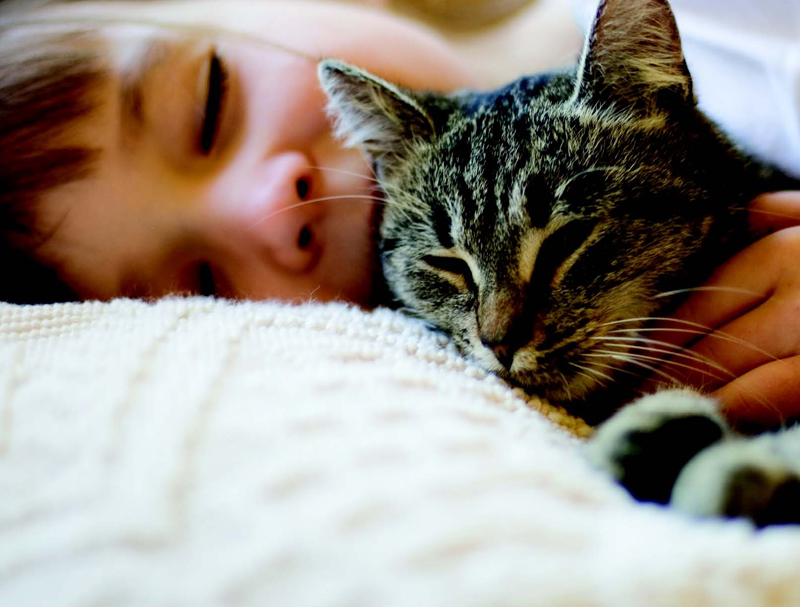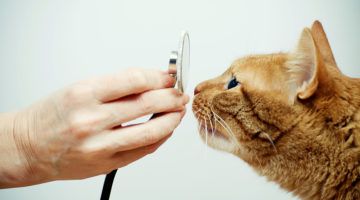Do you ever get the feeling your cat knows when you’re unwell, and even where it hurts? If you have a headache, he seems to know to settle down by your head. If it’s a stomachache, he’ll come and sit on your abdomen. And all the time he’s there, he purrs and purrs and purrs!
We all know a cat’s purr is relaxing and stress-reducing, but science has shown it can also be physically beneficial. It’s not just the sound of purring that’s important, but the vibration it produces.
Scientists have known for many years that vibrations at specific levels or frequencies cause healing changes in the body. These vibrations can induce bone growth and regeneration, so that bone fractures heal faster and weakened bones begin to strengthen and rebuild. Higher frequency ranges increase production of the body’s natural anti-inflammatory compounds, thereby reducing joint pain and swelling. Evidence suggests that these frequency ranges can repair muscles, tendons and ligaments, which has led to their use in sports medicine and gyms around the world, especially in the former Soviet Union where so much of this research has been conducted.
Various veterinary studies, meanwhile, indicate that cats rarely suffer bone or joint-related diseases, including hip dysplasia, arthritis and ligament problems. Even bone cancers, such as myeloma or osteosarcoma, are almost unheard of in cats. There’s even a popular saying amongst veterinarians: “If you put a cat and a bunch of broken bones in the same room, the bones will heal.”
It took researcher Elizabeth von Muggenthaler, a specialist in the field of bioacoustics at the Fauna Communications Research Institute in North Carolina (FCRI), to put two and two together. Bioacoustics is the study of the frequency, pitch, loudness, and duration of animal sounds as they relate to the animal’s behavior. Based on her research, Muggenthaler has proposed that purring is nature’s way of endowing felines with an evolutionary healing advantage.
Purring takes energy, and cats purr not only when all is well, but also when they are giving birth, hurt or scared. There has to be a very good reason for expending the energy needed to purr, especially when the cat is physically stressed or ill. In other words, the act of purring has to be somehow contributing to its survival. Nature doesn’t usually select traits without this evolutionary survival advantage, which means that contentment purring just doesn’t make the grade. There has to be another reason for it and Muggenthaler set out to find it.
She recorded and measured the purrs of 44 felids (members of the cat family), including cheetahs, ocelots, pumas, domestic cats, and servals. She found that all these cats generally purr in the range of 20 to 140 Hertz (Hz). Some are as high as 150 Hz but the average housecat comes in at about 25 to 50 Hz.
Interestingly, research has shown that exposure to frequencies at that same 20 to 50 Hz induces increased bone density, relieves pain and heals tendons and muscles.
Bone and joint problems may not be the only illnesses helped by a cat’s purring ability. For example, respiratory problems associated with heart disease are almost non-existent in cats. In fact, respiratory problems resolve quickly once purring is activated. In 1973, Dr. T. F. Cook published an article called “The Relief of Dyspnea in Cats by Purring” in the New Zealand Veterinary Journal. (Dyspnea is the condition of difficult breathing.) It seems a dying cat had such trouble breathing that the vets were considering euthanasia. But when the cat began to purr, it started breathing normally. The very act of purring appeared to open up his air passages.
Other healing mechanisms associated with purring include large skin-tissue grafts that take quickly in cats without necrotizing. Domestic cats also tend to be less prone to post-operative complications following surgery. The list goes on and on.
In effect then, by changing the frequency of their purring, cats may be fine tuning their healing abilities, a distinct evolutionary advantage. It is this unique advantage that has probably given rise to the notion of cats having nine lives, since they seem able to survive conditions that normally kill other animals, such as falls from heights. When researchers looked at the records of 132 cat falls from an average height of 5½ storeys, they found that 90% had survived. The record height for a cat falling and surviving is 45 storeys!
As Muggenthaler concludes, “An internal healing mechanism would be advantageous, increasing recovery time and keeping muscles and bone strong when sedentary.”
The extrapolation of this research may prove vital for human health too, and studies that expose tissue to frequencies of 20 to 50 Hz are ongoing. In 1999, for example, Dr. Clinton Rubin discovered that this exposure creates the robust striations associated with increased bone density, suggesting applications for osteoporosis, particularly in postmenopausal women and the elderly.
Ukrainian and Russian researchers discovered the benefits of vibratory stimulation many decades ago and have employed these techniques in sports training and medicine. Since the fall of the Iron Curtain, many of the treatment devices used by the Soviets have made their way into Western gyms and physical therapy treatment centers.
“…many individuals swear they can ease or completely eliminate their migraine headaches simply by lying down with a purring cat next to their head.”
Even the space program has benefited from the research. This breakthrough could help astronauts, who generally lose bone density in zero gravity, to maintain healthy bones and resist the problems of atrophy in outer space.
But it’s the cat’s “healing by association” that people find most interesting — that ability to sympathetically help cure illness in people simply by being around them. For instance, many individuals swear they can ease or completely eliminate their migraine headaches simply by lying down with a purring cat next to their head. And studies have shown that people with cats, especially senior citizens, have lower blood pressure and can live longer than people without cats.
Can’t get that minimum recommended daily dose of bone-enriching calcium? Holding your feline friend close may prove the answer to brittle bones. Having surgery? Perhaps keeping a cat nearby after coming home will reduce your recovery time. All good reasons to keep your cat happy and purring. You’re both likely to be healthier and you’ll have a great friend who truly understands how you’re feeling.







No Comment